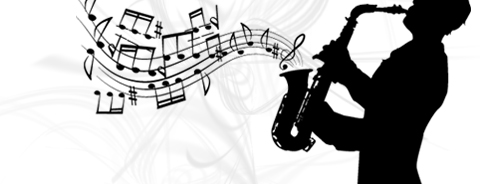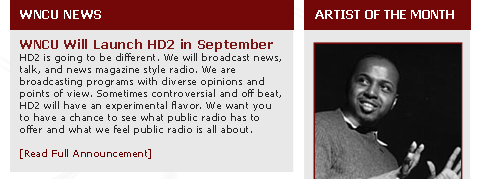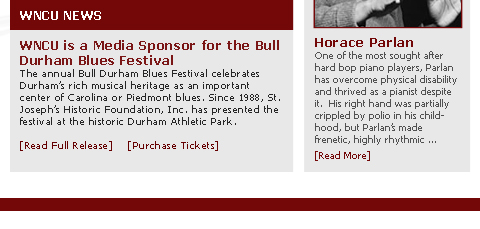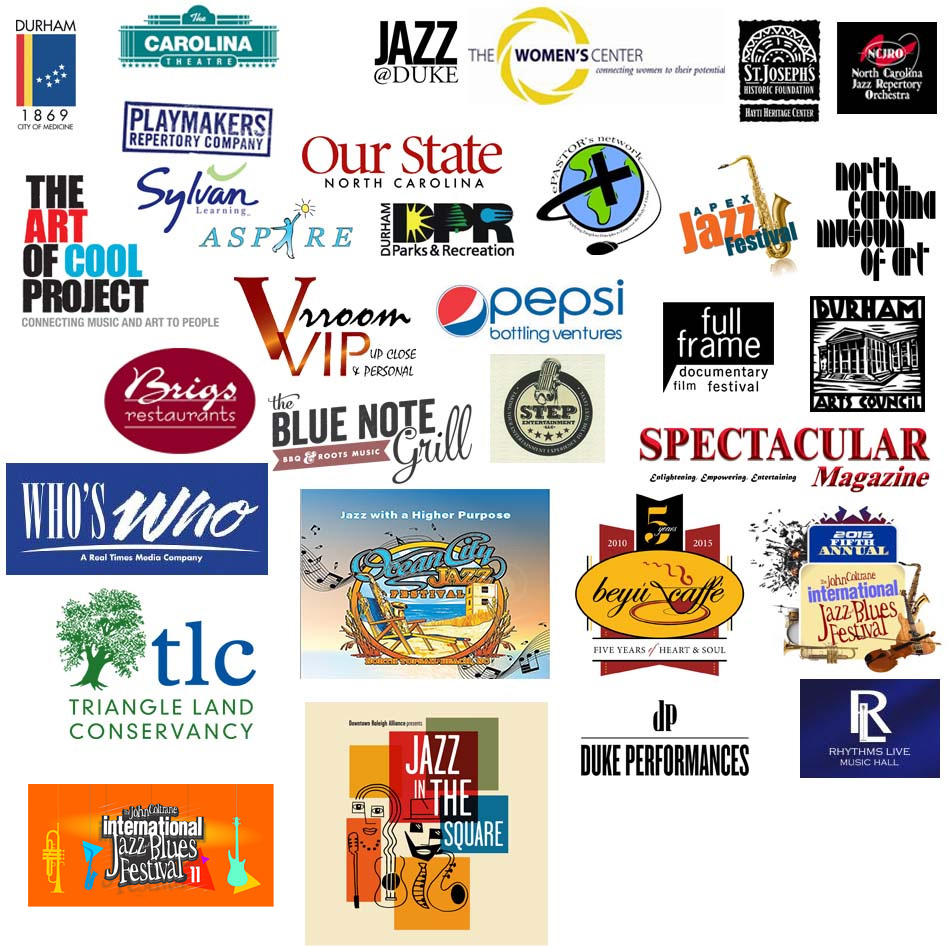Archive for August, 2010
Thursday, August 26th, 2010
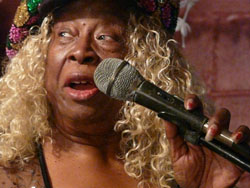 Still Singing the Blues features musicians in New Orleans and South Louisiana who continue to perform both traditional blues and rhythm-and-blues—often despite poverty, ill health, and the impacts of natural disasters like Hurricane Katrina. The hour-long documentary burrows into the lives of three outstanding older performers: Carol Fran of Lafayette, Harvey Knox of Baton Rouge, and Little Freddie King of New Orleans. Listeners will travel with these musicians to recording sessions, street corners, birthday celebrations, and neighborhood taverns. Still Singing the Blues features musicians in New Orleans and South Louisiana who continue to perform both traditional blues and rhythm-and-blues—often despite poverty, ill health, and the impacts of natural disasters like Hurricane Katrina. The hour-long documentary burrows into the lives of three outstanding older performers: Carol Fran of Lafayette, Harvey Knox of Baton Rouge, and Little Freddie King of New Orleans. Listeners will travel with these musicians to recording sessions, street corners, birthday celebrations, and neighborhood taverns.
Also interviewed are blues pianist and singer Marcia Ball; blues-and-funk guitarist Ernie Vincent; and Bethany Bultman, president of the New Orleans Musicians Clinic.
Accompanying this documentary is a web site, http://stillsingingtheblues.org, which features additional audio clips, photographs, a blog, and links for readers who want to obtain CDs, find music venues, and learn more about non-profit organizations that promote Louisiana’s music and support its musicians. The producers will add audio and photos to the site throughout the coming year.
Musical Works
| Title |
Artist |
Album |
Label |
Year Length |
| Tou’ Les Jours C’est Pas La Meme (Every Day Is Not The Same) |
Carol Fran |
Louisiana Swamp Stomp |
Honeybee Entertainment (unreleased) |
2010 00:00 |
| Emmitt Lee |
Carol Fran and Clarence Hollimon |
Gulf Coast Blues, Volume One. |
Black Top / Rounder Records |
1990 03:14 |
| Stormy Monday |
Carol Fran and Clarence Hollimon |
Carol Fran: Women in (E)motion |
Tradition & Moderne |
1993 05:57 |
| Daddy Daddy |
Carol Fran and Clarence Hollimon |
Carol Fran: Women in (E)motion |
Tradition & Moderne |
1993 02:35 |
| Peeping and HIding |
Carol Fran and Clarence Hollimon |
Carol Fran: Women in (E)motion |
Tradition & Moderne |
1993 05:44 |
| Track 3 |
Harvey Knox and the Soul Spectrum Band |
Natchez – Black Dots – LIVE |
Harvey Knox (unreleased) |
1987 05:27 |
| Track 4 |
Harvey Knox and the Soul Spectrum Band |
Natchez – Black Dots – LIVE |
Harvey Knox (unreleased) |
1987 05:21 |
| Crack Head Joe |
Little Freddie King |
You Don’t Know What I Know |
Fat Possum Records |
2005 04:05 |
| Goin Out da Mountain (Live) |
Little Freddie King |
Gotta Walk with Da King |
MadeWright Records |
2010 08:02 |
| Bus Station Blues (Live) |
Little Freddie King |
Gotta Walk with Da King |
MadeWright Records |
2010 07:23 |
| Pauger Street Boogie |
Little Freddie King |
Field Recording |
Yeoman and Ziglar (unreleased) |
2010 01:00 |
This documentary was sponsored by Filmmakers Collaborative with generous funding from a grant provided by the Louisiana Endowment for the Humanities, a state affiliate of the National Endowment for the Humanities. Narration was recorded by Dave Tilley of Bogue Sound Studios, Durham NC.
Posted in Music News | 7 Comments »
Monday, August 23rd, 2010
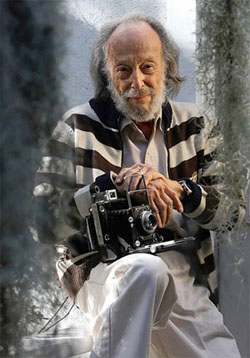 Originally published in The New York Times Originally published in The New York Times
Leonard’s smoke-filled images of jazz greats in dark clubs documented a musical era. Many of his black-and-white prints were lost in Hurricane Katrina.
Herman Leonard, a photographer best known for his iconic images of such jazz greats as Billie Holiday, Duke Ellington and Miles Davis, has died. He was 87.
Leonard died Saturday at Cedars-Sinai Medical Center in Los Angeles, a family spokeswoman said. No cause was given. He had been living in Los Angeles since Hurricane Katrina struck New Orleans in 2005, flooding his home and destroying thousands of prints.
Leonard became famous for the smoky, backlighted black-and-white photos he took in dark jazz clubs beginning in the late 1940s.
» Don’t miss a thing. Get breaking news alerts delivered to your inbox.
“I took advantage of being a photographer to get myself into the clubs so I could sit in front of Charlie Parker,” he told The Times in March before the opening of an exhibit on jazz photography at the Fahey/Klein Gallery in Los Angeles. “I got to listen to music in person. That enriched me. The money didn’t. And I tried to make images that would satisfy me.”
The images did much more than that. They documented a musical era and cemented Leonard’s status.
“He knows how to capture, and to make, the natural beauty, artistry and individuality of musicians shine through — shine through the paper and the chemicals and the book and the gallery and the years,” John Edward Hasse, of the Smithsonian Institution’s National Museum of American History, told the Morning Call in Allentown, Pa., in 1999. “He’s an artist.”
He was born in Allentown in 1923 and became interested in photography early on thanks to his older brother. He attended Ohio University to study photography but that was interrupted by a stint in the Army from 1943 to 1945. Leonard returned to college and graduated with a bachelor’s degree in 1947.
After working as an apprentice for famed portrait photographer Yousuf Karsh, Leonard moved to New York in 1948 and started becoming immersed in the jazz scene. Using a 4-by-5 Speed Graphic camera, he shot Art Tatum, Dizzy Gillespie, Sarah Vaughan and countless other jazz greats.
Ellington watching Ella Fitzgerald sing in 1948. Dexter Gordon sitting, holding a cigarette and balancing his saxophone on a knee. There was music, amazing access and plenty of smoke.
“The smoke was part of the atmosphere of those days and dramatized the photographs a lot, maybe over-stylized them a bit,” he told The Times in 1990.
He spent 1956 as a personal photographer for actor Marlon Brando on a trip to the Far East. Then he moved to Paris and did commercial work, including for Playboy magazine, and kept shooting jazz.
“Ninety-nine percent of everything I shot was off the cuff,” he said in 2001. “I wanted to capture what was really there untainted by anything I would do. My whole principle was to capture the mood and atmosphere of the moment.”
The negatives of his jazz photos had been put away when he left the United States; but beginning in the 1980s he rediscovered them, and his first book, “The Eye of Jazz,” was published in 1985. The first exhibition of Leonard’s jazz photos was held in London in 1988.
More exhibitions and praise followed.
Leonard’s work showed an intimacy that “comes from a true insider whose genuine friendship with the musicians allowed him to capture moments that are personal and insightful,” David Houston, chief curator of the Ogden Museum of Southern Art in New Orleans, told the Morning Call in 2005. “You could teach the personal and musical evolution of jazz in the ’50s through his work.”
Leonard moved to New Orleans in 1992. His home was flooded by Hurricane Katrina and he lost thousands of prints. But his 60,000 negatives were safe, having been sent before the hurricane to the Ogden Museum. His return to New Orleans was chronicled in the 2006 documentary “Saving Jazz.”
“When I was photographing Miles or Dizzy in the early days, I knew these were good and important musicians, but not as important as they turned out to be,” he told the Chicago Tribune in 1999. “I had no idea. If I had any inkling, I would have shot 10 times as many pictures.”
Leonard is survived by children Valerie, Shana, Michael and David; and six grandchildren.
Posted in Music News | 11 Comments »
Monday, August 23rd, 2010
The following times are approximates.
Newport Jazz Festival 2010
7 am – Conrad Herwig
8 am – Matt Wilson
9 am – Trio da Paz
10 am – Fly
11 am – Amina Figerova
12 pm – Darcy James Big Band
1 pm – J.D. Allen
2 pm – Marshall Allan w/ Matthew Shipp
3 pm – Ben Allison
4 pm – David Binney
5 pm – Maria Schneider
6 pm – Democrocy Now
7 pm – Rez Abassi Acoustic Band
Detroit Jazz Festival 2009
8 pm – Hour One – Dave Brubeck, Eddie Daniels, DeeDee Bridgewater, Gerald Wilson Orch., Sheila Jordan, Sean Jones and Christian McBride
9 pm – Hour Two – T.S. Monk, Janis Seigel w/ Detroit Jazz Festival Orchestra, Stefon Harris and Urbanus, Louis Hayes Cannonball Legacy Band, John Pizzarelli, Geri Allen Trio and Clayton Brothers w/ Scott Gwinell Big Band
WNCU Regular Schedule
10 pm – Jazz at Lincoln Center
11 pm – Overnight-Bob Parlocha
Posted in Music News | 4 Comments »
Tuesday, August 17th, 2010

Make your deposit by September 15, 2010, on the official NCCU Rose Parade Tour. Visit www.nccu.edu/tournamentofroses for full details and to make your reservations.
The tour options include:
- Five or four night stay at the Sheraton Park Hotel at the Anaheim Resort
- Group airfare or Individual air travel
- Reserved grandstand parade seating
- Ticket to Dec. 30 Band Fest
- Parade float barn construction tour
- Airport transfers
- Local transportation to all package events with a local host
- Official Tournament of Roses Program
- NCCU social events: Welcome Reception and local hospitality provide by the NCCU Alumni Association Los Angeles Chapter
- Optional tours and option to purchase Rose Bowl tickets
Questions? Email [email protected] or call (919) 530-6363.
Posted in Public Affairs | 4 Comments »
Tuesday, August 17th, 2010
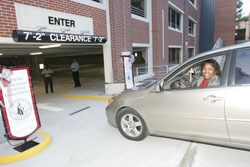 North Carolina Central University Chancellor Charlie Nelms became the first official to pass the gates at the newly opened Latham Parking Deck, the university’s first high-rise parking structure. North Carolina Central University Chancellor Charlie Nelms became the first official to pass the gates at the newly opened Latham Parking Deck, the university’s first high-rise parking structure.
Latham, a $15-million, 750-space parking deck, opened on scheduled at 7 a.m. Monday. Spaces in the deck cost $450, and entitle purchasers to a reserved, numbered space. A free shuttle service takes deck users to various stops throughout campus.
Moments before driving into the deck, Nelms was joined by Willie Williams, NCCU’s police chief, and Zack Abegunrin, associate vice chancellor for facilities management, in cutting a ribbon to ceremonially open the facility. The first fifty NCCU employees who entered the deck received a Centennial keepsake as a “Garage Door Prize.”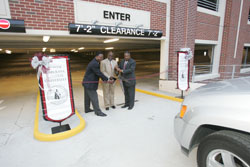
NCCU’s other large parking areas are surface lots. Latham, at the corner of Lawson and Lincoln streets, also will accommodate a bookstore and a campus police substation. That section of the building should be completed by November 19.
The facility takes the name of the former structure at the site, Latham Residence Hall. It was named for the highly regarded Louise M. Latham, dean of women from 1948 to 1968.
For information about parking, call the NCCU Police Department at 530-6106.
Posted in Public Affairs | 6 Comments »
Tuesday, August 17th, 2010
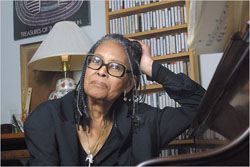 Originally published in The New York Times Originally published in The New York Times
Abbey Lincoln, a singer whose dramatic vocal command and tersely poetic songs made her a singular figure in jazz, died on Saturday in Manhattan. She was 80 and lived on the Upper West Side.
Her death was announced by her brother David Wooldridge.
Ms. Lincoln’s career encompassed outspoken civil rights advocacy in the 1960s and fearless introspection in more recent years, and for a time in the 1960s she acted in films, including one with Sidney Poitier.
Long recognized as one of jazz’s most arresting and uncompromising singers, Ms. Lincoln gained similar stature as a songwriter only over the last two decades. Her songs, rich in metaphor and philosophical reflection, provide the substance of “Abbey Sings Abbey,” an album released on Verve in 2007. As a body of work, the songs formed the basis of a three-concert retrospective presented by Jazz at Lincoln Center in 2002.
Her singing style was unique, a combined result of bold projection and expressive restraint. Because of her ability to inhabit the emotional dimensions of a song, she was often likened to Billie Holiday, her chief influence. But Ms. Lincoln had a deeper register and a darker tone, and her way with phrasing was more declarative.
“Her utter individuality and intensely passionate delivery can leave an audience breathless with the tension of real drama,” Peter Watrous wrote in The New York Times in 1989. “A slight, curling phrase is laden with significance, and the tone of her voice can signify hidden welts of emotion.”
She had a profound influence on other jazz vocalists, not only as a singer and composer but also as a role model. “I learned a lot about taking a different path from Abbey,” the singer Cassandra Wilson said. “Investing your lyrics with what your life is about in the moment.”
Ms. Lincoln was born Anna Marie Wooldridge in Chicago on Aug. 6, 1930, the 10th of 12 children, and raised in rural Michigan. In the early 1950s, she headed west in search of a singing career, spending two years as a nightclub attraction in Honolulu, where she met Ms. Holiday and Louis Armstrong. She then moved to Los Angeles, where she encountered the accomplished lyricist Bob Russell.
It was at the suggestion of Mr. Russell, who had become her manager, that she took the name Abbey Lincoln, a symbolic conjoining of Westminster Abbey and Abraham Lincoln. In 1956, she made her first album, “Affair … a Story of a Girl in Love” (Liberty), and appeared in her first film, the Jayne Mansfield vehicle “The Girl Can’t Help It.” Her image in both cases was decidedly glamorous: On the album cover she was depicted in a décolleté gown, and in the movie she sported a dress once worn by Marilyn Monroe.
For her second album, “That’s Him,” released on the Riverside label in 1957, Ms. Lincoln kept the seductive pose but worked convincingly with a modern jazz ensemble that included the tenor saxophonist Sonny Rollins and the drummer Max Roach. In short order she came under the influence of Mr. Roach, a bebop pioneer with an ardent interest in progressive causes. As she later recalled, she put the Monroe dress in an incinerator and followed his lead.
The most visible manifestation of their partnership was “We Insist! Max Roach’s Freedom Now Suite,” issued on the Candid label in 1960, with Ms. Lincoln belting Oscar Brown Jr.’s lyrics. Now hailed as an early masterwork of the civil rights movement, the album radicalized Ms. Lincoln’s reputation. One movement had her moaning in sorrow, and then hollering and shrieking in anguish — a stark evocation of struggle. A year later, after Ms. Lincoln sang her own lyrics to a song called “Retribution,” her stance prompted one prominent reviewer to deride her in print as a “professional Negro.”
Ms. Lincoln, who married Mr. Roach in 1962, was for a while more active as an actress than a singer. In 1964 she starred with Ivan Dixon in “Nothing but a Man,” a tale of the Deep South in the 1960s, and in 1968 she was the title character opposite Mr. Poitier in the romantic comedy “For Love of Ivy,” playing a white family’s maid. She also acted on television in guest-starring roles in the ’60s and ’70s.
But with the exception of “Straight Ahead” (Candid), on which “Retribution” appeared, she released no albums in the 1960s. And after her divorce from Mr. Roach in 1970, she took an apartment above a garage in Los Angeles and withdrew from the spotlight for a time. She never remarried.
In addition to Mr. Wooldridge, Ms. Lincoln is survived by another brother, Kenneth Wooldridge, and a sister, Juanita Baker.
During a visit to Africa in 1972, Ms. Lincoln received two honorary appellations from political officials: Moseka, in Zaire, and Aminata, in Guinea. (Moseka would occasionally serve as her surname.) She began to consider her calling as a storyteller and focused on writing songs.
Moving back to New York in the 1980s, Ms. Lincoln resumed performing, eventually attracting the attention of Jean-Philippe Allard, a producer and executive with PolyGram France. Ms. Lincoln’s first effort for what is now the Verve Music Group, “The World Is Falling Down” (1990), was a commercial and critical success.
Eight more albums followed in a similar vein, each produced by Mr. Allard and enlisting top-shelf jazz musicians like the tenor saxophonist Stan Getz and the vibraphonist Bobby Hutcherson. In addition to elegant originals like “Throw It Away” and “When I’m Called Home,” the albums featured Ms. Lincoln’s striking interpretations of material ranging from songbook standards to Bob Dylan’s “Mr. Tambourine Man.”
For “Abbey Sings Abbey” Ms. Lincoln revisited her own songbook exclusively, performing in an acoustic roots-music setting that emphasized her affinities with singer-songwriters like Mr. Dylan. Overseen by Mr. Allard and the American producer-engineer Jay Newland, the album boiled each song to its essence and found Ms. Lincoln in weathered voice but superlative form.
When the album was released in May 2007, Ms. Lincoln was recovering from open-heart surgery. In her Upper West Side apartment, surrounded by her own paintings and drawings, she reflected on her life, often quoting from her own song lyrics. After she recited a long passage from “The World Is Falling Down,” one of her more prominent later songs, her eyes flashed with pride. “I don’t know why anybody would give that up,” she said. “I wouldn’t. Makes my life worthwhile.”
Posted in Music News | 2 Comments »
Saturday, August 14th, 2010
 The Peabody Award–winning radio series, Jazz at Lincoln Center (JALC) Radio with Wendell Pierce, has moved to Monday evening at 10pm, starting August 16. To learn more, click here. The Peabody Award–winning radio series, Jazz at Lincoln Center (JALC) Radio with Wendell Pierce, has moved to Monday evening at 10pm, starting August 16. To learn more, click here.
Posted in Music News | 5 Comments »
Saturday, August 14th, 2010
Posted in eNewsletter | Comments Off on August 2010 WNCU eNewsletter
Friday, August 13th, 2010
On labor day, Monday, September 6, WNCU will air sets from 2 of the country’s foremost jazz festivals. Starting off with the mother of them all, it will be the 2010 Newport Jazz Festival with selected sets featuring Maria Schneider, Matt Wilson, Conrad Herwig, Amina Figerova, Trio da Paz, J.D. Allen, and more.
We will also air 2 hours of the 2009 Detroit Jazz festival featuring Dave Brubeck, DeeDee Bridgewater, Gerald Wilson Orchestra, Christian McBride, Sean Jones, Geri Allen, Louis Hayes Cannonball Legacy Band, Stefon Harris & Urbanus, and T.S. Monk & The Monk.
Posted in Music News | 2 Comments »
Friday, August 13th, 2010
Got your HD radio yet? WNCU will launch our 2nd channel, HD2, in September.
HD2 is going to be different. We will broadcast news, talk, and news magazine style radio. We are broadcasting programs with diverse opinions and points of view. Sometimes controversial and off beat, HD2 will have an experimental flavor. We want you to have a chance to see what public radio has to offer and what we feel public radio is all about.
There will be music programs that showcase sounds from around the world and of course there will be our award winning mainstream jazz programming.
A complete listing of WNCU HD2 programs will be available soon.
Posted in Music News | 11 Comments »
|
 Still Singing the Blues features musicians in New Orleans and South Louisiana who continue to perform both traditional blues and rhythm-and-blues—often despite poverty, ill health, and the impacts of natural disasters like Hurricane Katrina. The hour-long documentary burrows into the lives of three outstanding older performers: Carol Fran of Lafayette, Harvey Knox of Baton Rouge, and Little Freddie King of New Orleans. Listeners will travel with these musicians to recording sessions, street corners, birthday celebrations, and neighborhood taverns.
Still Singing the Blues features musicians in New Orleans and South Louisiana who continue to perform both traditional blues and rhythm-and-blues—often despite poverty, ill health, and the impacts of natural disasters like Hurricane Katrina. The hour-long documentary burrows into the lives of three outstanding older performers: Carol Fran of Lafayette, Harvey Knox of Baton Rouge, and Little Freddie King of New Orleans. Listeners will travel with these musicians to recording sessions, street corners, birthday celebrations, and neighborhood taverns.

 Originally published in The New York Times
Originally published in The New York Times
 North Carolina Central University Chancellor Charlie Nelms became the first official to pass the gates at the newly opened Latham Parking Deck, the university’s first high-rise parking structure.
North Carolina Central University Chancellor Charlie Nelms became the first official to pass the gates at the newly opened Latham Parking Deck, the university’s first high-rise parking structure.
 Originally published in The New York Times
Originally published in The New York Times The Peabody Award–winning radio series, Jazz at Lincoln Center (JALC) Radio with Wendell Pierce, has moved to Monday evening at 10pm, starting August 16. To learn more, click
The Peabody Award–winning radio series, Jazz at Lincoln Center (JALC) Radio with Wendell Pierce, has moved to Monday evening at 10pm, starting August 16. To learn more, click 
